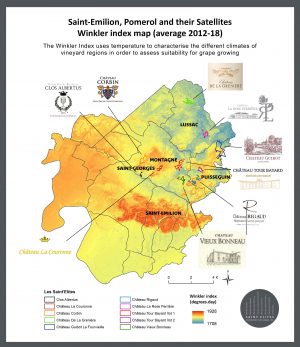Les Saint-Elites is slightly cooler than Saint- Emilion, which has historically been seen as something of a handicap. Now, in light of the changing climate, it has become an asset.
Having felt their terroirs remained still too often in the shadow of the Saint-Emilion appellation, eight friends – winegrowers from leading family wineries with references in the communal appellations of Saint-Emilion, Saint-Georges Saint-Emilion, Montagne Saint- Emilion, Puisseguin Saint-Emilion and Lussac Saint-Emilion – chose to create Saint-Elites.

The Saint-Elites Terroir
In order to demonstrate that they belong to the great terroirs of Saint-Emilion, the Saint-Elites winegrowers commissioned Cornelis van Leeuwen, professor of viticulture and specialist in wine-growing terroirs, to carry out an in-depth scientific study of their terroirs. Inseparable from the vines and from a rigorous selection of grape varieties, the terroir is characterised by three major elements: the soil, the climate and the winegrowers.
The Soil
The Saint-Elites appellations are located towards the northernmost part of the Saint-Emilion PDO, with geographical similarities. The constituent elements of the Saint-Elites soils help to explain the quality of their wines – true gems from the Saint-Emilionnais appellations.
The Climate
Van Leeuwen’s study of Saint-Elites’ terroir shows that the local appellations of Saint-Emilion are generally a bit cooler than the Saint- Emilion and Pomerol appellations. Historically, those lower temperatures were a handicap since the grapes didn’t mature until later in the year – or not at all in unfavourable years. However, in the context of global warming, this has become an advantage because this freshness brings balance and aromatic complexity to wines produced with a dominant Merlot.

Above: Jean-Pierre Dubreuil, Château de la Grenière (Lussac Saint-Emilion), Brigitte Destouet, Château Guibot la Fourvieille (Puisseguin Saint-Emilion), Pierre Taïx, La Mauriane (Puisseguin Saint-Emilion), Julien Richard, Château Tour Bayard (Montagne Saint-Emilion), Franck Despagne, Château Vieux Bonneau (Montagne Saint-Emilion), Thomas Thiou, Château La Couronne (Montagne Saint-Emilion), Jean-Luc and Claire Sylvain, Château La Rose Perrière (Lussac Saint-Emilion), Jacques Rambeaud, Clos Albertus (Saint-Georges Saint-Emilion)
The Winemakers
Facing new challenges, the Saint-Elites winegrowers innovate and adapt. With high standards, precision and patience, each Saint-Elites winemaker works hard to develop wines that express the greatness of their terroir.
 Complete study available upon request – email: contact@saintelites.com
Complete study available upon request – email: contact@saintelites.com
For more information visit www.saintelites.com
Facebook @lessaintelites
Instagram @saint_elites







